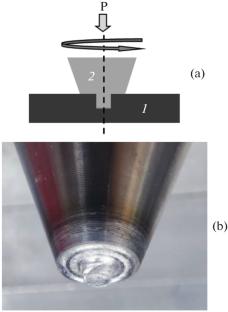An effect of friction forces on the structure and composition of the near-surface layer of an Al–13Sn–5Fe (at %) composite containing a large amount of agglomerates of FeAl3 particles cemented with tin was studied. The investigated composite was prepared by sintering a mixture of Al, Sn, and Fe elemental powders in vacuum for 1 h at a temperature of 620°C and subsequent compaction in a closed die at a pressure of about 300 MPa and a temperature of 250°C. The counterbody was made of heat-resistant X40CrMoV5-1 steel and was a truncated steel cone with a helical surface. The speed of material points lying on the outer perimeter of the section of the rotating cone pressed against the composite was 0.36 and 0.54 m/s. The normal pressure on the end surface of the composite specimen was 16 and 32 MPa with a load on the cone of 150 and 300 kg, respectively. It was found that three layers are formed under the friction surface, which differ in the value of the accumulated deformation. The closer to the friction surface the layer is located, the narrower it is. The uppermost layer consists of highly crushed iron aluminide particles mixed with ultrafine tin and aluminum particles. It also contains a lot of oxygen in the form of fragments of oxide films, which is why it has a high microhardness, reaching 2000 MPa or more. The thickness of this layer increases with increasing processing pressure and reaches several hundred micrometers. Based on the results of the study, it is concluded that pretreatment of the surface of aluminum matrix composites by smoothing with a flat steel counterbody leads to its charging. This fact will increase its wear resistance, however, the optimal mode of such processing and the shape of the processing tool require additional research.



